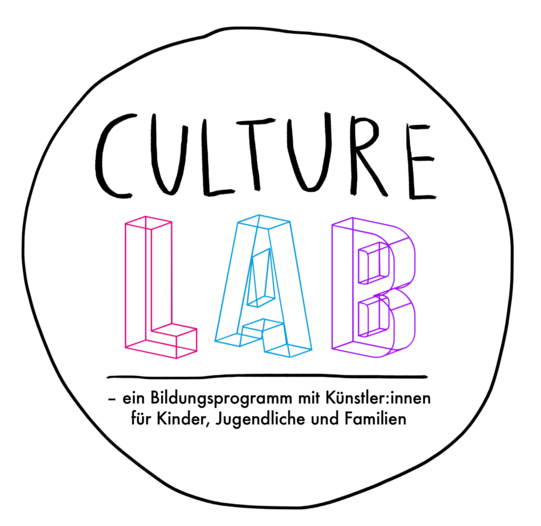Culture LAB - an educational program with artists for children, youth and families
A research project by Prof. Dr. Werner Thole and Tim Isenberg (M.A) in cooperation with the Youth and Social Office of the City of Frankfurt and the Crespo Foundation.
Culture LAB - An educational program with artists for children, youth and families

State of knowledge
At the latest since the National Education Report with its focus on "Cultural Education", which emphasizes the central importance of non-formal educational opportunities for the artistic-cultural activities of children and young people in the fields of performing arts and music, a high relevance has been assigned to extracurricular artistic, cultural-aesthetic activities of children and young people in Germany. Despite a number of research and evaluation findings, the significance and impact of children's and young people's involvement in the aesthetic and musical-cultural areas of activity still seems to be largely unclear.
Cultural education processes of children and adolescents have so far been studied more extensively, especially in the school sector and in the context of "music"-oriented studies. The available results indicate a positive change in technical skills as well as social-communicative competencies through musical offerings (formal and informal). Less reliable results are available for disciplines such as theater, dance, film and digital media, as well as visual arts in the field of extracurricular education.
Question and goals
Following on from the observation that children and young people are particularly affected by the pandemic situation that has now lasted more than two years, the City of Frankfurt am Main has launched a "Cultural Education" action plan as part of the Corona Action Plan. Under the title "CultureLab for children, young people, families and artists - an educational program", the Youth and Social Welfare Office of the City of Frankfurt am Main and the Crespo Foundation will realize cultural-aesthetic projects in various children's and youth facilities in Frankfurt over the next two years and implement them with a sustainable, i.e. long-term perspective beyond the current funding phase. From the point of view of child and youth welfare as well as from a general research perspective, it is
- firstly, it is interesting to see what effects result from the participation of children and young people in the services, courses and projects,
- secondly, it is important whether the organizational, content-related and personnel-related conditions in the facilities in which the offers are realized have changed, whether new offers have been created and established and whether new pedagogical practices have been realized or are to be realized.
- Thirdly, it is of interest what experiences the participating artists can report, how they evaluate the projects and how they see them in contrast to other activities.
Methodology
Children and young people - participant survey
In as many of the 40 programs as possible, all participating children and adolescents are to be surveyed at the beginning and end of the program using a standardized questionnaire. The changes between the beginning and the end of the program will be surveyed using a longitudinal design. In the analyses, it is assumed that different influences are relevant for the question of the effects and the experience of educational processes, such as the social context, age and gender, individual prerequisites as well as the structure and process quality of the offers. In addition to self-assessments of personality traits, the questionnaires designed for the survey time points are used to record self-assessments regarding acquired knowledge and skills.
In a non-standardized, conversation- and discourse-oriented sub-study, the focus will be on the social side of cultural-aesthetic offerings. The focus will be on the connection between the respective group constellations in the offers and the cultural-aesthetic contents, educational approaches, experiences and experiences offered within this framework. Thus, the interpretations and thematizations of the adolescents can be generated from their participation in the offers and from the aesthetic-cultural offers. In total, between four and six group interviews selected according to theoretical sampling will be collected.
Group discussion with pedagogues of the institutions
Two to three group discussions will be conducted with pedagogues or representatives of the institutions. Pedagogues from different institutions should take part in the discussions, report on their experiences with regard to a controversially modeled opening stimulus, and discuss them. In this way, interpretations and thematizations of the pedagogues regarding the relevance and effects of the cultural-aesthetic offers can be centrally registered.
Group discussion with artists
In two to three group discussions with artists from different disciplines, initiated by a controversially modeled opening stimulus, they will exchange their experiences and in particular discuss the meanings and the effects of the cultural-aesthetic offerings as perceived by them.
The findings generated by the research project will be presented to the Youth and Social Office of the City of Frankfurt am Main, the participating institutions and artists as well as the Crespo Foundation parallel to the research project. Among other things, it is planned to present and discuss the first results at a Jour Fixe at the beginning of 2023. Until the final report is presented in mid-2024, interim results will also be made available and discussed in the second half of 2023. In addition to the production of scientific publications, a recommendation for action will be developed by all participants - researchers, artists, educators and project managers. The scientific findings will be incorporated into the recommendation for action.
Literature selection on the topic
Autorengruppe Bildungsberichterstattung (2012). Bildung in Deutschland 2012. Bielefeld.
Calmbach, Marc/Rhein, Stefanie (2007): DIY or die! – Überlegungen zur Vermittlung und Aneignung von Do-it-yourself-Kompetenzen in der Jugendkultur Hardcore. In: Göttlich, U./Müller, R./Rhein, St./Calmbach, M. (Hrsg.): Arbeit, Politik und Religion in Jugendkulturen (69-86). Weinheim: Ju-venta.
Grgic, Mariana/Züchner, Ivo (2013): Medien, Kultur und Sport. Was Kinder und Jugendliche machen und ihnen wichtig ist. Die MediKus-Studie. Weinheim/Basel: Beltz Juventa.
Kamp, Peter/Nierstheimer, Julia (2012): Alle Künste unter einem Dach – Jugendkunstschule als konzeptioneller Rahmen. In: Zacharias, Wolfgang (Hrsg.): Handbuch Kulturelle Bildung. München: kopaed.
Lindner, Werner (2003): „Ich lerne zu leben“. Evaluation von Bildungswirkungen in der kulturellen Kinder- und Jugendarbeit in Nordrhein-Westfalen. Unna: LKD.
Medienpädagogischer Forschungsverbund Südwest (MPFS): JIM-Studie 2020. Jugend, Information, (Multi)-Media). Stuttgart: mpfs.
Nohl, Arnd-Michael (2013): Komparative Analyse. Forschungspraxis und Methodologie dokumentarischer Interpretation. In: Bohnsack, R./Nentwig-Gesemann, I./Nohl, A.-M. (Hrsg.): Die dokumen-tarische Methode und ihre Forschungspraxis (271-293). Wiesbaden: Springer.
Preiß, Christine (2008): Leben und Lernen mit Musik. In: Wahler, Peter/Tully, Claus J./Preiß, Chris-tine (Hrsg.): Jugendliche in neuen Lebenswelten (2. erw. Aufl.) (143-164). Wiesbaden: VS.
Rohde, J./Thole, W. (Hrsg.) (2021): Kulturell-ästhetische Bildungsprozesse in Jugendkunstschulen und kulturpädagogischen Projekten. Wiesbaden: Springer VS.
Thole, Werner/Züchner, Ivo/Stuckert, Marina/Müller, Roy/Rauschkolb, Jaqueline (2017): „... auf jeden Fall anders als Schule und [...] viel entspannter“. Bildungsprozesse in kulturell-ästhetischen Projekten (JuArt). In: Rat für Kulturelle Bildung e.V. (Hrsg.): Wenn. Dann (20-30). Essen.http://www.rat-kulturelle-bildung.de/fileadmin/user_upload/pdf/RKB_02_ABSCHLUSSBE-RICHT_08_WEB.pdf.


